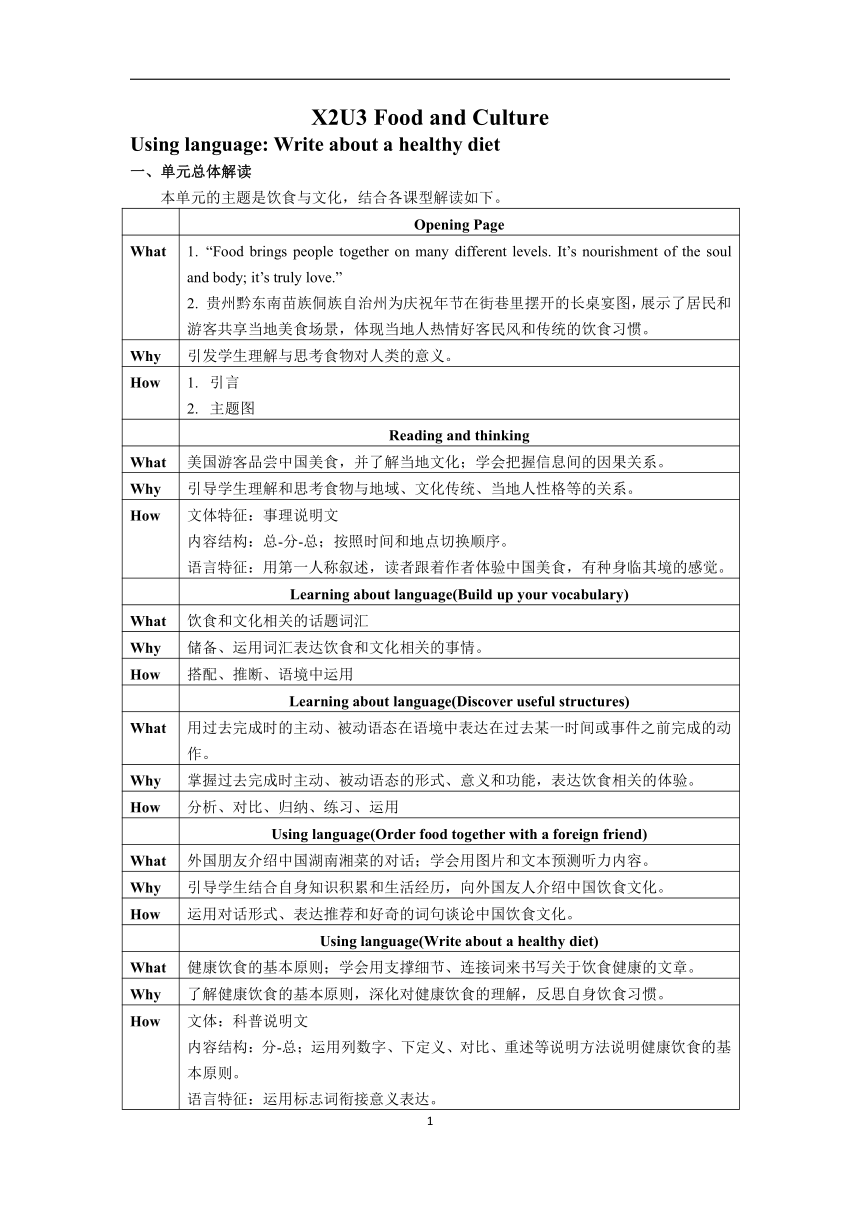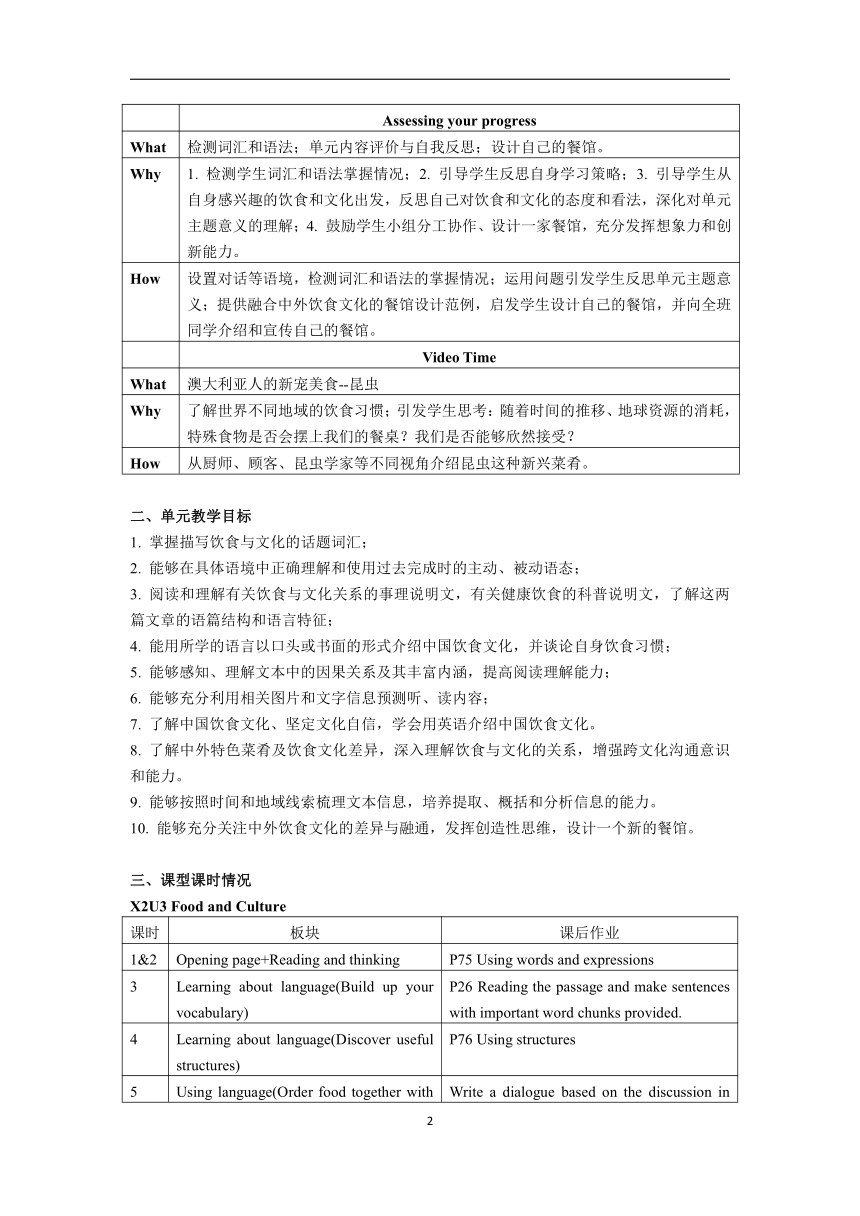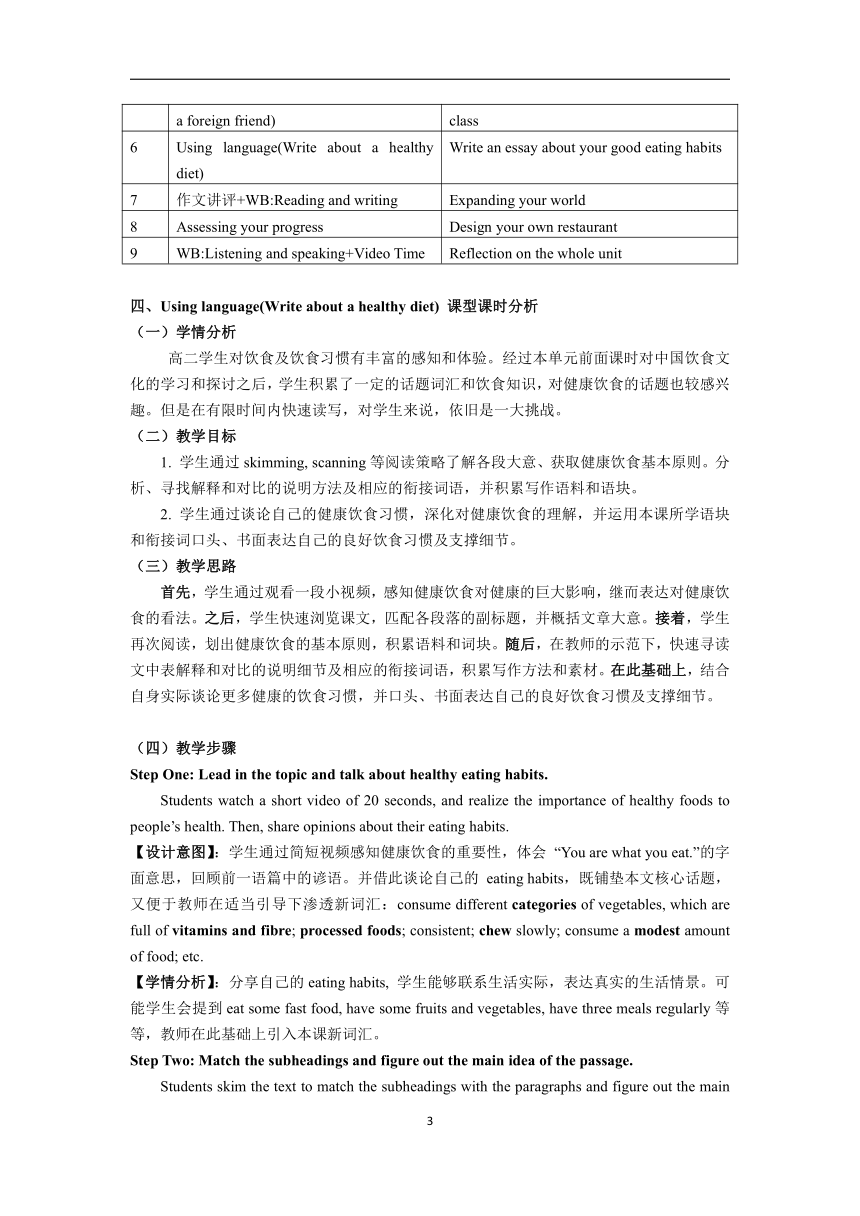人教版(2019)选择性必修二 Unit 3 Food and Culture Using language 教学设计(表格式)
文档属性
| 名称 | 人教版(2019)选择性必修二 Unit 3 Food and Culture Using language 教学设计(表格式) |

|
|
| 格式 | docx | ||
| 文件大小 | 2.0MB | ||
| 资源类型 | 教案 | ||
| 版本资源 | 人教版(2019) | ||
| 科目 | 英语 | ||
| 更新时间 | 2023-04-25 16:48:23 | ||
图片预览



文档简介
X2U3 Food and Culture
Using language: Write about a healthy diet
一、单元总体解读
本单元的主题是饮食与文化,结合各课型解读如下。
Opening Page
What “Food brings people together on many different levels. It’s nourishment of the soul and body; it’s truly love.” 贵州黔东南苗族侗族自治州为庆祝年节在街巷里摆开的长桌宴图,展示了居民和游客共享当地美食场景,体现当地人热情好客民风和传统的饮食习惯。
Why 引发学生理解与思考食物对人类的意义。
How 引言 主题图
Reading and thinking
What 美国游客品尝中国美食,并了解当地文化;学会把握信息间的因果关系。
Why 引导学生理解和思考食物与地域、文化传统、当地人性格等的关系。
How 文体特征:事理说明文 内容结构:总-分-总;按照时间和地点切换顺序。 语言特征:用第一人称叙述,读者跟着作者体验中国美食,有种身临其境的感觉。
Learning about language(Build up your vocabulary)
What 饮食和文化相关的话题词汇
Why 储备、运用词汇表达饮食和文化相关的事情。
How 搭配、推断、语境中运用
Learning about language(Discover useful structures)
What 用过去完成时的主动、被动语态在语境中表达在过去某一时间或事件之前完成的动作。
Why 掌握过去完成时主动、被动语态的形式、意义和功能,表达饮食相关的体验。
How 分析、对比、归纳、练习、运用
Using language(Order food together with a foreign friend)
What 外国朋友介绍中国湖南湘菜的对话;学会用图片和文本预测听力内容。
Why 引导学生结合自身知识积累和生活经历,向外国友人介绍中国饮食文化。
How 运用对话形式、表达推荐和好奇的词句谈论中国饮食文化。
Using language(Write about a healthy diet)
What 健康饮食的基本原则;学会用支撑细节、连接词来书写关于饮食健康的文章。
Why 了解健康饮食的基本原则,深化对健康饮食的理解,反思自身饮食习惯。
How 文体:科普说明文 内容结构:分-总;运用列数字、下定义、对比、重述等说明方法说明健康饮食的基本原则。 语言特征:运用标志词衔接意义表达。
Assessing your progress
What 检测词汇和语法;单元内容评价与自我反思;设计自己的餐馆。
Why 检测学生词汇和语法掌握情况;2. 引导学生反思自身学习策略;3. 引导学生从自身感兴趣的饮食和文化出发,反思自己对饮食和文化的态度和看法,深化对单元主题意义的理解;4. 鼓励学生小组分工协作、设计一家餐馆,充分发挥想象力和创新能力。
How 设置对话等语境,检测词汇和语法的掌握情况;运用问题引发学生反思单元主题意义;提供融合中外饮食文化的餐馆设计范例,启发学生设计自己的餐馆,并向全班同学介绍和宣传自己的餐馆。
Video Time
What 澳大利亚人的新宠美食--昆虫
Why 了解世界不同地域的饮食习惯;引发学生思考:随着时间的推移、地球资源的消耗,特殊食物是否会摆上我们的餐桌?我们是否能够欣然接受?
How 从厨师、顾客、昆虫学家等不同视角介绍昆虫这种新兴菜肴。
二、单元教学目标
1. 掌握描写饮食与文化的话题词汇;
2. 能够在具体语境中正确理解和使用过去完成时的主动、被动语态;
3. 阅读和理解有关饮食与文化关系的事理说明文,有关健康饮食的科普说明文,了解这两篇文章的语篇结构和语言特征;
4. 能用所学的语言以口头或书面的形式介绍中国饮食文化,并谈论自身饮食习惯;
5. 能够感知、理解文本中的因果关系及其丰富内涵,提高阅读理解能力;
6. 能够充分利用相关图片和文字信息预测听、读内容;
7. 了解中国饮食文化、坚定文化自信,学会用英语介绍中国饮食文化。
8. 了解中外特色菜肴及饮食文化差异,深入理解饮食与文化的关系,增强跨文化沟通意识和能力。
9. 能够按照时间和地域线索梳理文本信息,培养提取、概括和分析信息的能力。
10. 能够充分关注中外饮食文化的差异与融通,发挥创造性思维,设计一个新的餐馆。
三、课型课时情况
X2U3 Food and Culture
课时 板块 课后作业
1&2 Opening page+Reading and thinking P75 Using words and expressions
3 Learning about language(Build up your vocabulary) P26 Reading the passage and make sentences with important word chunks provided.
4 Learning about language(Discover useful structures) P76 Using structures
5 Using language(Order food together with a foreign friend) Write a dialogue based on the discussion in class
6 Using language(Write about a healthy diet) Write an essay about your good eating habits
7 作文讲评+WB:Reading and writing Expanding your world
8 Assessing your progress Design your own restaurant
9 WB:Listening and speaking+Video Time Reflection on the whole unit
四、Using language(Write about a healthy diet) 课型课时分析
(一)学情分析
高二学生对饮食及饮食习惯有丰富的感知和体验。经过本单元前面课时对中国饮食文化的学习和探讨之后,学生积累了一定的话题词汇和饮食知识,对健康饮食的话题也较感兴趣。但是在有限时间内快速读写,对学生来说,依旧是一大挑战。
(二)教学目标
1. 学生通过skimming, scanning等阅读策略了解各段大意、获取健康饮食基本原则。分析、寻找解释和对比的说明方法及相应的衔接词语,并积累写作语料和语块。
2. 学生通过谈论自己的健康饮食习惯,深化对健康饮食的理解,并运用本课所学语块和衔接词口头、书面表达自己的良好饮食习惯及支撑细节。
(三)教学思路
首先,学生通过观看一段小视频,感知健康饮食对健康的巨大影响,继而表达对健康饮食的看法。之后,学生快速浏览课文,匹配各段落的副标题,并概括文章大意。接着,学生再次阅读,划出健康饮食的基本原则,积累语料和词块。随后,在教师的示范下,快速寻读文中表解释和对比的说明细节及相应的衔接词语,积累写作方法和素材。在此基础上,结合自身实际谈论更多健康的饮食习惯,并口头、书面表达自己的良好饮食习惯及支撑细节。
(四)教学步骤
Step One: Lead in the topic and talk about healthy eating habits.
Students watch a short video of 20 seconds, and realize the importance of healthy foods to people’s health. Then, share opinions about their eating habits.
【设计意图】:学生通过简短视频感知健康饮食的重要性,体会 “You are what you eat.”的字面意思,回顾前一语篇中的谚语。并借此谈论自己的 eating habits,既铺垫本文核心话题,又便于教师在适当引导下渗透新词汇:consume different categories of vegetables, which are full of vitamins and fibre; processed foods; consistent; chew slowly; consume a modest amount of food; etc.
【学情分析】:分享自己的eating habits, 学生能够联系生活实际,表达真实的生活情景。可能学生会提到eat some fast food, have some fruits and vegetables, have three meals regularly等等,教师在此基础上引入本课新词汇。
Step Two: Match the subheadings and figure out the main idea of the passage.
Students skim the text to match the subheadings with the paragraphs and figure out the main idea of the passage.
【设计意图】:学生跳读、匹配各段落的副标题,从而理清文章结构,获取文章主旨大意:健康饮食的基本原则。
【学情分析】:经过长期训练,学生已有跳读意识和习惯,可以在较短时间内快速获取主要信息。
Step Three: Underline the rules for healthy eating.
Students scan the text and underline the rules for healthy eating. Then, when some students share their findings of rules, the teacher guides them to summarize some rules, and meanwhile write down key words on the blackboard.
【设计意图】:学生寻读健康饮食的基本原则,并在文本中标注。学生分享自己所找的rules时候,教师在幻灯片上进行标注,既可以帮助学生验证、准确定位文本信息,又可以在这过程中引导学生通过关注上下文、观看图片等方式学习新词汇,如cut down on, cut out, dairy products, moderation, chew, consistent, etc.
【学情分析】:学生已成关注文本、阅读留痕的好习惯,会用不同颜色的荧光笔标注不同层级的信息。在留痕迹的过程中,强化内容,关注语言。
Step Four: Find the sentences and linking words to show explanation or contrast to the rules.
Students find the sentences and linking words to show explanation or contrast to the rules, after exploring the example of para3 guided by the teacher.
【设计意图】:教师以第三段为例,示范学生分析rules的支撑细节所运用的解释和对比的说明方法,并板书表达解释和对比的linking words: which, as, without/with; rather than. 之后,让学生再次自主阅读,自主观察和发现。教师在学生回答的过程中,继续板书表达解释关系的词块put more simply, what this means is that...,板书表达对比关系的词语however, rather.
【学情分析】:根据教师示范来自主阅读,分析、获取信息,学生已较为熟悉该自主学习的模式。在自主阅读过程中,体验explanation和contrast的细节运用,为后续模仿输出打下基础。
Step Five: Share their own good eating habits orally.
In this step, it’s time for students to use what they have learned about healthy eating in this class. They read a letter with the first and last paragraph provided for them, and then realize that they have to share their own good eating habits in the body part. So they first share with their desk mates and then some students will share with whole class.
【设计意图】:学生结合自身实际,口头分享自身良好饮食习惯,既是对文本中rules for healthy eating的回顾,又可以激发学生想出课文中未提及但自身拥有的良好饮食习惯,深化对该话题的理解。
【学情分析】:在一定的饮食习惯内容和语言的阅读和强化后,学生可以更好地结合自身实际来表达,并有了一定的词块支撑。可能的分享的点如下:I often consume different categories of fruits and vegetables, which are full of vitamins and fibre; It’s important to consume mineral water instead of sweet drinks; I manage to cut out the snack of fried food; I always have a big breakfast with quantities of nutrition every day; etc.
Step Six: Write down two of their good eating habits with details and linking words.
Before students begin to write their good eating habits, the teacher just takes one of them shared by students and makes it as an example to guide them to add details by using explanation and also the related linking word orally. After that, students try to write two of their good eating habits and add details.
【设计意图】:从学生现场生成的good eating habits中选择一个作为示范,指导学生口头添加原因来作为支撑细节,并关注衔接词的运用。比如学生口头提到:It’s important to consume mineral water instead of sweet drinks,教师就可以追问why not consume sweet drinks 从学生齐答中得出they consist of much sugar,教师再提示which is the real.....,学生就能答killer of health. 同时,教师就在黑板上板书下关键信息,能让学生体验支撑细节的添加过程就行。为学生独立完成一小段good eating habits+details(linking words)的书面文字做好内容、结构,以及心理上的支撑。
【学情分析】:学生在教师的示范下体验支撑细节的添加方式和过程,提升写作表达信心,开始大胆体验写作过程,对本文所学知识内容进行转换输出。
Step Seven: Appreciate the writing with the guidance of the checklist.
Students can appreciate their writing from the following aspects if they have already finished their task. The teacher takes one as an example from students and then guide them to appreciate.
【设计意图】:评价单聚焦本课目标,学生可以按照标准进行自我评价和提升。从读到说、写、评,体现教学评的一致性。
【学情分析】:评价单作为检验单,学生感受到学习的逐步深化,从而获得学习的收获感。
(五)板书设计
Healthy Eating Rules Details linking words consume cut down on desserts, cut out sweet drinks which... categories consume a balanced diet with fresh foods as/because.. vitamins develop slow, consistent and modest eating habits explanation without/with.. fibre have a healthy attitude put more simply processed foods What this means is.. chew rather than modest contrast however rather
(六)课后作业
1. Improve the writing with the guidance of the checklist.
7
Using language: Write about a healthy diet
一、单元总体解读
本单元的主题是饮食与文化,结合各课型解读如下。
Opening Page
What “Food brings people together on many different levels. It’s nourishment of the soul and body; it’s truly love.” 贵州黔东南苗族侗族自治州为庆祝年节在街巷里摆开的长桌宴图,展示了居民和游客共享当地美食场景,体现当地人热情好客民风和传统的饮食习惯。
Why 引发学生理解与思考食物对人类的意义。
How 引言 主题图
Reading and thinking
What 美国游客品尝中国美食,并了解当地文化;学会把握信息间的因果关系。
Why 引导学生理解和思考食物与地域、文化传统、当地人性格等的关系。
How 文体特征:事理说明文 内容结构:总-分-总;按照时间和地点切换顺序。 语言特征:用第一人称叙述,读者跟着作者体验中国美食,有种身临其境的感觉。
Learning about language(Build up your vocabulary)
What 饮食和文化相关的话题词汇
Why 储备、运用词汇表达饮食和文化相关的事情。
How 搭配、推断、语境中运用
Learning about language(Discover useful structures)
What 用过去完成时的主动、被动语态在语境中表达在过去某一时间或事件之前完成的动作。
Why 掌握过去完成时主动、被动语态的形式、意义和功能,表达饮食相关的体验。
How 分析、对比、归纳、练习、运用
Using language(Order food together with a foreign friend)
What 外国朋友介绍中国湖南湘菜的对话;学会用图片和文本预测听力内容。
Why 引导学生结合自身知识积累和生活经历,向外国友人介绍中国饮食文化。
How 运用对话形式、表达推荐和好奇的词句谈论中国饮食文化。
Using language(Write about a healthy diet)
What 健康饮食的基本原则;学会用支撑细节、连接词来书写关于饮食健康的文章。
Why 了解健康饮食的基本原则,深化对健康饮食的理解,反思自身饮食习惯。
How 文体:科普说明文 内容结构:分-总;运用列数字、下定义、对比、重述等说明方法说明健康饮食的基本原则。 语言特征:运用标志词衔接意义表达。
Assessing your progress
What 检测词汇和语法;单元内容评价与自我反思;设计自己的餐馆。
Why 检测学生词汇和语法掌握情况;2. 引导学生反思自身学习策略;3. 引导学生从自身感兴趣的饮食和文化出发,反思自己对饮食和文化的态度和看法,深化对单元主题意义的理解;4. 鼓励学生小组分工协作、设计一家餐馆,充分发挥想象力和创新能力。
How 设置对话等语境,检测词汇和语法的掌握情况;运用问题引发学生反思单元主题意义;提供融合中外饮食文化的餐馆设计范例,启发学生设计自己的餐馆,并向全班同学介绍和宣传自己的餐馆。
Video Time
What 澳大利亚人的新宠美食--昆虫
Why 了解世界不同地域的饮食习惯;引发学生思考:随着时间的推移、地球资源的消耗,特殊食物是否会摆上我们的餐桌?我们是否能够欣然接受?
How 从厨师、顾客、昆虫学家等不同视角介绍昆虫这种新兴菜肴。
二、单元教学目标
1. 掌握描写饮食与文化的话题词汇;
2. 能够在具体语境中正确理解和使用过去完成时的主动、被动语态;
3. 阅读和理解有关饮食与文化关系的事理说明文,有关健康饮食的科普说明文,了解这两篇文章的语篇结构和语言特征;
4. 能用所学的语言以口头或书面的形式介绍中国饮食文化,并谈论自身饮食习惯;
5. 能够感知、理解文本中的因果关系及其丰富内涵,提高阅读理解能力;
6. 能够充分利用相关图片和文字信息预测听、读内容;
7. 了解中国饮食文化、坚定文化自信,学会用英语介绍中国饮食文化。
8. 了解中外特色菜肴及饮食文化差异,深入理解饮食与文化的关系,增强跨文化沟通意识和能力。
9. 能够按照时间和地域线索梳理文本信息,培养提取、概括和分析信息的能力。
10. 能够充分关注中外饮食文化的差异与融通,发挥创造性思维,设计一个新的餐馆。
三、课型课时情况
X2U3 Food and Culture
课时 板块 课后作业
1&2 Opening page+Reading and thinking P75 Using words and expressions
3 Learning about language(Build up your vocabulary) P26 Reading the passage and make sentences with important word chunks provided.
4 Learning about language(Discover useful structures) P76 Using structures
5 Using language(Order food together with a foreign friend) Write a dialogue based on the discussion in class
6 Using language(Write about a healthy diet) Write an essay about your good eating habits
7 作文讲评+WB:Reading and writing Expanding your world
8 Assessing your progress Design your own restaurant
9 WB:Listening and speaking+Video Time Reflection on the whole unit
四、Using language(Write about a healthy diet) 课型课时分析
(一)学情分析
高二学生对饮食及饮食习惯有丰富的感知和体验。经过本单元前面课时对中国饮食文化的学习和探讨之后,学生积累了一定的话题词汇和饮食知识,对健康饮食的话题也较感兴趣。但是在有限时间内快速读写,对学生来说,依旧是一大挑战。
(二)教学目标
1. 学生通过skimming, scanning等阅读策略了解各段大意、获取健康饮食基本原则。分析、寻找解释和对比的说明方法及相应的衔接词语,并积累写作语料和语块。
2. 学生通过谈论自己的健康饮食习惯,深化对健康饮食的理解,并运用本课所学语块和衔接词口头、书面表达自己的良好饮食习惯及支撑细节。
(三)教学思路
首先,学生通过观看一段小视频,感知健康饮食对健康的巨大影响,继而表达对健康饮食的看法。之后,学生快速浏览课文,匹配各段落的副标题,并概括文章大意。接着,学生再次阅读,划出健康饮食的基本原则,积累语料和词块。随后,在教师的示范下,快速寻读文中表解释和对比的说明细节及相应的衔接词语,积累写作方法和素材。在此基础上,结合自身实际谈论更多健康的饮食习惯,并口头、书面表达自己的良好饮食习惯及支撑细节。
(四)教学步骤
Step One: Lead in the topic and talk about healthy eating habits.
Students watch a short video of 20 seconds, and realize the importance of healthy foods to people’s health. Then, share opinions about their eating habits.
【设计意图】:学生通过简短视频感知健康饮食的重要性,体会 “You are what you eat.”的字面意思,回顾前一语篇中的谚语。并借此谈论自己的 eating habits,既铺垫本文核心话题,又便于教师在适当引导下渗透新词汇:consume different categories of vegetables, which are full of vitamins and fibre; processed foods; consistent; chew slowly; consume a modest amount of food; etc.
【学情分析】:分享自己的eating habits, 学生能够联系生活实际,表达真实的生活情景。可能学生会提到eat some fast food, have some fruits and vegetables, have three meals regularly等等,教师在此基础上引入本课新词汇。
Step Two: Match the subheadings and figure out the main idea of the passage.
Students skim the text to match the subheadings with the paragraphs and figure out the main idea of the passage.
【设计意图】:学生跳读、匹配各段落的副标题,从而理清文章结构,获取文章主旨大意:健康饮食的基本原则。
【学情分析】:经过长期训练,学生已有跳读意识和习惯,可以在较短时间内快速获取主要信息。
Step Three: Underline the rules for healthy eating.
Students scan the text and underline the rules for healthy eating. Then, when some students share their findings of rules, the teacher guides them to summarize some rules, and meanwhile write down key words on the blackboard.
【设计意图】:学生寻读健康饮食的基本原则,并在文本中标注。学生分享自己所找的rules时候,教师在幻灯片上进行标注,既可以帮助学生验证、准确定位文本信息,又可以在这过程中引导学生通过关注上下文、观看图片等方式学习新词汇,如cut down on, cut out, dairy products, moderation, chew, consistent, etc.
【学情分析】:学生已成关注文本、阅读留痕的好习惯,会用不同颜色的荧光笔标注不同层级的信息。在留痕迹的过程中,强化内容,关注语言。
Step Four: Find the sentences and linking words to show explanation or contrast to the rules.
Students find the sentences and linking words to show explanation or contrast to the rules, after exploring the example of para3 guided by the teacher.
【设计意图】:教师以第三段为例,示范学生分析rules的支撑细节所运用的解释和对比的说明方法,并板书表达解释和对比的linking words: which, as, without/with; rather than. 之后,让学生再次自主阅读,自主观察和发现。教师在学生回答的过程中,继续板书表达解释关系的词块put more simply, what this means is that...,板书表达对比关系的词语however, rather.
【学情分析】:根据教师示范来自主阅读,分析、获取信息,学生已较为熟悉该自主学习的模式。在自主阅读过程中,体验explanation和contrast的细节运用,为后续模仿输出打下基础。
Step Five: Share their own good eating habits orally.
In this step, it’s time for students to use what they have learned about healthy eating in this class. They read a letter with the first and last paragraph provided for them, and then realize that they have to share their own good eating habits in the body part. So they first share with their desk mates and then some students will share with whole class.
【设计意图】:学生结合自身实际,口头分享自身良好饮食习惯,既是对文本中rules for healthy eating的回顾,又可以激发学生想出课文中未提及但自身拥有的良好饮食习惯,深化对该话题的理解。
【学情分析】:在一定的饮食习惯内容和语言的阅读和强化后,学生可以更好地结合自身实际来表达,并有了一定的词块支撑。可能的分享的点如下:I often consume different categories of fruits and vegetables, which are full of vitamins and fibre; It’s important to consume mineral water instead of sweet drinks; I manage to cut out the snack of fried food; I always have a big breakfast with quantities of nutrition every day; etc.
Step Six: Write down two of their good eating habits with details and linking words.
Before students begin to write their good eating habits, the teacher just takes one of them shared by students and makes it as an example to guide them to add details by using explanation and also the related linking word orally. After that, students try to write two of their good eating habits and add details.
【设计意图】:从学生现场生成的good eating habits中选择一个作为示范,指导学生口头添加原因来作为支撑细节,并关注衔接词的运用。比如学生口头提到:It’s important to consume mineral water instead of sweet drinks,教师就可以追问why not consume sweet drinks 从学生齐答中得出they consist of much sugar,教师再提示which is the real.....,学生就能答killer of health. 同时,教师就在黑板上板书下关键信息,能让学生体验支撑细节的添加过程就行。为学生独立完成一小段good eating habits+details(linking words)的书面文字做好内容、结构,以及心理上的支撑。
【学情分析】:学生在教师的示范下体验支撑细节的添加方式和过程,提升写作表达信心,开始大胆体验写作过程,对本文所学知识内容进行转换输出。
Step Seven: Appreciate the writing with the guidance of the checklist.
Students can appreciate their writing from the following aspects if they have already finished their task. The teacher takes one as an example from students and then guide them to appreciate.
【设计意图】:评价单聚焦本课目标,学生可以按照标准进行自我评价和提升。从读到说、写、评,体现教学评的一致性。
【学情分析】:评价单作为检验单,学生感受到学习的逐步深化,从而获得学习的收获感。
(五)板书设计
Healthy Eating Rules Details linking words consume cut down on desserts, cut out sweet drinks which... categories consume a balanced diet with fresh foods as/because.. vitamins develop slow, consistent and modest eating habits explanation without/with.. fibre have a healthy attitude put more simply processed foods What this means is.. chew rather than modest contrast however rather
(六)课后作业
1. Improve the writing with the guidance of the checklist.
7
